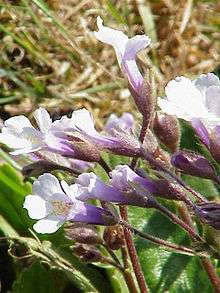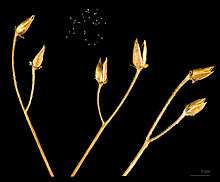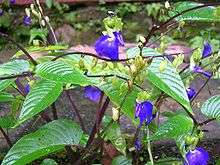Gesneriaceae
Gesneriaceae, the African violet family,[2][3] is a family of flowering plants consisting of about 152 genera and ca. 3,540 species[4] in the Old World (most Cyrtandroideae) and New World (Gesnerioideae) tropics and subtropics, with a very small number extending to temperate areas. Many species have colorful and showy flowers and are cultivated as ornamental plants.
| Gesneriaceae | |
|---|---|
 | |
| Streptocarpus ionanthus (an African violet) - a common household plant and a member of the family | |
| Scientific classification | |
| Kingdom: | Plantae |
| Clade: | Tracheophytes |
| Clade: | Angiosperms |
| Clade: | Eudicots |
| Clade: | Asterids |
| Order: | Lamiales |
| Family: | Gesneriaceae Rich. & Juss. ex DC[1] |
| Subfamilies | |
| |



Etymology
The family name is based on the genus Gesneria, which honours Swiss naturalist and humanist Conrad Gessner.
Description
Most species are herbaceous perennials or subshrubs but a few are woody shrubs or small trees. The phyllotaxy is usually opposite and decussate, but leaves have a spiral or alternate arrangement in some groups. As with other members of the Lamiales the flowers have a (usually) zygomorphic corolla whose petals are fused into a tube and there is no one character that separates a gesneriad from any other member of Lamiales.[3] Gesneriads differ from related families of the Lamiales in having an unusual inflorescence structure, the "pair-flowered cyme", but some gesneriads lack this characteristic, and some other Lamiales (Calceolariaceae and some Scrophulariaceae) share it. The ovary can be superior, half-inferior or fully inferior, and the fruit a dry or fleshy capsule or a berry. The seeds are always small and numerous. Gesneriaceae have traditionally been separated from Scrophulariaceae by having a unilocular rather than bilocular ovary, with parietal rather than axile placentation.
On the basis of both morphological and biogeographical differences the family is divided into two major subfamilies: subfamily Cyrtandroideae in the Old World and subfamily Gesnerioideae in the New World. The biggest and most widespread genus is Cyrtandra, with about 600 species widely distributed in Southeast Asia, Malaysia, Indonesia, the Philippines, and the islands of the Pacific as far away as the Hawaiian Islands.
Taxonomy
Several molecular systematic studies have shown that Gesneriaceae are not closely related to any other family of the Lamiales, but more recently a sister-group relationship with Calceolariaceae has been suggested. Other studies have suggested that two Latin American genera generally placed in other families, Sanango and Peltanthera, are more closely related to Gesneriaceae than to any other members of the Lamiales but there is as yet no consensus on whether those genera should be included in the family.
The genus Rehmannia has sometimes been included in Gesneriaceae but is now referred to the family Orobanchaceae.
Several genera in the family have become popular as houseplants. One of the most familiar members of the family to gardeners are the African violets in Streptocarpus section Saintpaulia. Gesneriads are divided culturally into three groups on the basis of whether, and how, their stems are modified into storage organs: rhizomatous, tuberous, and "fibrous-rooted", meaning those that lack such storage structures (although all gesneriads have fibrous roots).
Botanists who have made significant contributions to the systematics of the family are George Bentham, Robert Brown, B.L. Burtt, C.B. Clarke, Olive Mary Hilliard, Joseph Dalton Hooker, William Jackson Hooker, Karl Fritsch, Elmer Drew Merrill, Harold E. Moore, Jr., John L. Clark, Conrad Vernon Morton, Henry Nicholas Ridley, Laurence Skog, W.T. Wang, Anton Weber, and Hans Wiehler. Several researchers are currently working on this group and the generic classification has been changing rapidly.
The Gesneriad Society, Inc. is an international horticultural society devoted to the promotion, cultivation, and study of Gesneriaceae.
Selected genera

- Achimenes
- Aeschynanthus
- Agalmyla
- Alloplectus
- Alsobia
- Amalophyllon
- Ancylostemon
- Anna
- Anodiscus
- Asteranthera
- Besleria
- Boea
- Briggsia
- Bucinellina
- Capanea
- Chirita
- Chiritopsis
- Chrysothemis
- Codonanthe
- Codonoboea
- Columnea (Flying goldfish plant)
- Conandron
- Corallodiscus
- Coronanthera
- Corytoplectus
- Crantzia - often included in Alloplectus
- Cyrtandra
- Depanthus
- Deinostigma
- Diastema
- Didissandra
- Didymocarpus
- Drymonia
- Episcia (Flame violet)
- Eucodonia
- Fieldia
- Gasteranthus
- Gesneria
- Glossoloma - often included in Alloplectus
- Gloxinella
- Gloxinia
- Gloxiniopsis
- Haberlea
- Hemiboea
- Henckelia
- Isometrum
- Jankaea
- Jerdonia
- Koellikeria
- Kohleria
- Lenbrassia
- Liebigia
- Loxocarpus
- Loxostigma
- Lysionotus
- Mandirola
- Microchirita
- Mitraria
- Monophyllaea
- Monopyle
- Napeanthus
- Nautilocalyx
- Negria
- Nematanthus (Goldfish plant)
- Neomortonia
- Niphaea
- Nomopyle
- Opithandra
- Oreocharis
- Paliavana
- Paraboea
- Paradrymonia
- Pearcea
- Petrocodon
- Petrocosmea
- Phinaea
- Primulina
- Ramonda
- Raphiocarpus
- Reldia
- Rhabdothamnus
- Rhynchoglossum
- Rhytidophyllum
- Saintpaulia (African violet)
- Sanango
- Sarmienta
- Seemannia
- Senyumia
- Sinningia
- Smithiantha (Temple bells)
- Solenophora
- Sphaerorrhiza
- Stauranthera
- Streptocarpus (Cape primrose)
- Titanotrichum
- Tremacron
References
- Angiosperm Phylogeny Group (2009). "An update of the Angiosperm Phylogeny Group classification for the orders and families of flowering plants: APG III" (PDF). Botanical Journal of the Linnean Society. 161 (2): 105–121. doi:10.1111/j.1095-8339.2009.00996.x. Retrieved 2013-07-06.
- "Gesneriaceae - plant family". Encyclopedia Britannica.
- "Encyclopedia of Life". eol.org.
- Christenhusz, M. J. M.; Byng, J. W. (2016). "The number of known plants species in the world and its annual increase". Phytotaxa. 261 (3): 201–217. doi:10.11646/phytotaxa.261.3.1.
External links
| Wikimedia Commons has media related to Gesneriaceae. |
| Wikispecies has information related to Gesneriaceae |
- World Checklist of Gesneriaceae
- Genera of Gesneriaceae
- Gesneriad Reference Web
- Gesneriaceae: A Scientific Overview, by Prof. Anton Weber (on the Gesneriad Reference Web)
- Gesneriaceae in Flora of China
- The Gesneriad Society (formerly the American Gloxinia and Gesneriad Society)
- Annotated Bibliography of the Gesneriaceae
- Phylogenetic relationships in the Gesnerioideae (Gesneriaceae) based on nrDNA ITS and cpDNA trnL-F and trnE-T spacer region sequences (link to abstract)
- Evolution of Cyrtandra (Gesneriaceae) in the Pacific Ocean: the origin of a supertramp clade
- Weber, A. 2004. Gesneriaceae and Scrophulariaceae: Robert Brown and now. Telopea 10(2): 543-571.
- Gesneriaceae: All you need to know about gesneriads.